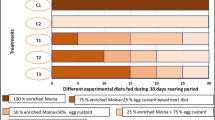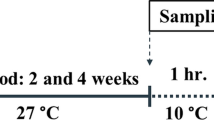Abstract
The transfer of L-ascorbic acid (AA) from broodstock to the fertilised eggs and it's dynamics in embryos and fasting larvae, has been studied in sea bass (Dicentrarchus labrax L.) and sea bream (Sparus aurata L.). Two types of diets were fed to the broodstocks: one containing sufficient ascorbate for normal growth and the other with an extra addition of a very high dose (2,000 mg/kg feed) of ethyl-cellulose-coated L-ascorbic acid.
The concentration of AA and total ascorbate (L-ascorbic acid plus dehydroascorbic acid) was detected through several embryo and larval development stages, including larvae just before feeding. In sea bass and sea bream, the mean (SD) concentration of total ascorbate in fertilised eggs originating from broodstock fed AA supplemented diet, was 218.5 (17.7) and 122.4 (5.1) μg/g wet weight respectively. This was significantly higher (P < 0.01) than the unsupplemented groups, which contained only 155.9 (6.9) and 103.9 (3.5) μg/g wet weight respectively. A diet with a vitamin C content adequate for normal growth, may not be sufficient for broodstock when the goal is transfer of TAA to embryos. © Rapid Science Ltd. 1998
Similar content being viewed by others
REFERENCES
Barnabé, G. (1990) Rearing bass and gilthead bream. In: Aquaculture 2(ed. G. Barnab) Ellis Horwood, London. pp. 648-686.
Barnes, M.J. and Kodicek, E. (1972) Biological hydroxylations and ascorbic acid with special regard to collagen metabolism. Vitamins and Hormons 30, 1-43.
Blom, J.H. and Dabrowski, K. (1995) Reproductive success of female rainbow trout (Oncorhynchus mykiss) in response to graded dietary ascorbyl monophosphate levels. Biology of Reproduction 52, 1073-1080.
Boglione, C., Marino, G., Bertolini, B., Rossi, A., Ferreri, F. and Cataudella, S. (1993) Larval and postlarval monitoring in sea bass: morphological approach to evaluate finfish seed quality. In: Production, Environmental and Quality(eds. G. Barnabé and P. Kestemont) European Aquaculture Society: Oostende, Belgium, pp. 189-204.
Coombs, S.H., Fosh, C.A., and Keen, M.N.A. (1985) The buoyancy and vertical distribution of eggs of sprat (Sprattus sprattus) and pilchard (Sardina pilchardus). Journal of the Marine Biological Association U.K. 65, 461-474.
Cowey, C.B., Bell, J.G., Knox, D., Fraser, A. and Youngson, A. (1985) Lipids and lipid antioxidant systems in developing eggs of salmon (Salmo salar). Lipids 20, 567-572.
Dabrowski, K. (1991) Ascorbic acid status in high-mountain charr (Salvelinus alpinusL.) in relation to the reproductive cycle. Environmental Biology of Fishes 31, 213-217.
Dabrowski, K. and Hinterleitner, S. (1989) Applications of a simultaneous assay of ascorbic acid, dehydroascorbic acid and ascorbic sulphate in biological materials. Analyst 114, 83-87.
Halver, J.E., Smith, R.R., Tolbert, B.M. and Baker, E.M. (1975) Utilisation of ascorbic acid in fish. Annals of the New York Academy of Sciences 258, 81-102.
Hapette, A.M., Coombs, S., Williams, R. and Poulet, S.A. (1991) Variation in Vitamin C content of sprat larvae (Sprattus sprattus) in the Irish sea. Marine Biology 108, 39-48.
Hilton, J.W., Cho, C.Y., Brown, R.G. and Slinger, S.J. (1979) The synthesis, half-life and distribution of ascorbic acid in rainbow trout. Comparative Biochemistry and Physiology 63A, 447-453.
Levine, M. and Morita, K. (1985) Ascorbic acid in endocrine systems. Vitamins and Hormones 42, 1-64.
Merchie, G., Lavens, P., Dhert, P., Pector, R., Mai Soni, A.F., Abbes, M., Nelis, H., Ollevier, F., De Leenheer, A., Sorgeloos, P. (1995) Live food mediated vitamin C transfer to Dicentrarchus labraxand Clarias gariepinus. Journal of Applied Ichthyology 11, 336-341.
Roe, J.H. and Kuether, C.A. (1943) The determination of ascorbic acid in whole blood and urine through the 2,4-dinitrophenylhydrazine derivative of dehydroascorbic acid. Journal of Biological Chemistry 147, 399-407.
Sandnes, K. and Braekkan, O.R. (1981) Ascorbic acid and the reproductive cycle of ovaries in cod (Gadus morhua). Comparative Biochemistry and Physiology 70A, 545-546.
Sandnes, K., Ulgenes, Y., Braekkan, O.R. and Utne, F. (1984) The effect of ascorbic acid supplementation in broodstock feed on reproduction in rainbow trout (Salmo gairdneri) Aquaculture 43, 167-177.
Saroglia, M., Scarano, G., Sciaraffia, F. and Mazzatura, A. (1991) Essenzialita' della vitamina C in dieta per spigola (Dicentrarchus labraxL. ). I-Individuazione del fabbisogno minimo per la crescita e per la saturazione del tessuto epatico. In Atti IX Congresso Associazione Scientifica Produzione Animale (ASPA). ISMEA: Roma, 1055-1065.
Seymour, E.A. (1981). The effect of powdered carp pituitary on ovarian development, ovarian ascorbic acid and ovulation in Carassius carassiusL. exposed to various photoperiod and temperature regimes. Journal of Fish Biology 19, 675-682.
Soliman, A.K., Jauncey, K., Roberts, R.J. (1986) The effect of dietary ascorbic acid supplementation on hatchability, survival rate and fry performance in Oreochromis mosambicus. Aquaculture 59, 197-208.
Summers, C.B. and Felton, G.W. (1993) Antioxidant role of dehydroascorbic acid reductase in insects. Biochimica et Biophysica Acta 1156, 235-238.
Tolbert, B.M., Downing, M., Carlson, R.W., Knight, M.K. and Baker, E.M. (1975) Chemistry and metabolism of ascorbic acid and ascorbic acid sulphate. Annals of the New York Academy of Sciences 258, 48-69.
Tyler, C.R., Sumpter, J.P., Bromage, N.R. (1988a) In vivo ovarian uptake and processing of vitellogenin in the rainbow trout, Salmo gairdneri. Journal of Experimental Zoology 246, 171-179.
Tyler, C.R., Sumpter, J.P. and Bromage, N.R. (1988b) Selectivity of protein sequestration by vitellogenic oocytes of rainbow trout, Salmo gairdneri. Journal of Experimental Zoology 248, 199-206.
Waagbø, R., Thorsen, T., Sandnes, K. (1989) Role of dietary ascorbic acid in vitellogenesis in rainbow trout (Salmo gairdneri). Aquaculture 80, 301-314.
Author information
Authors and Affiliations
Rights and permissions
About this article
Cite this article
Terova, G., Saroglia, M., Papp, Z.G. et al. Ascorbate dynamics in embryos and larvae of sea bass and sea bream, originating from broodstocks fed supplements of ascorbic acid. Aquaculture International 6, 357–367 (1998). https://doi.org/10.1023/A:1009237022692
Issue Date:
DOI: https://doi.org/10.1023/A:1009237022692




